DJI Mavic 3 Pro
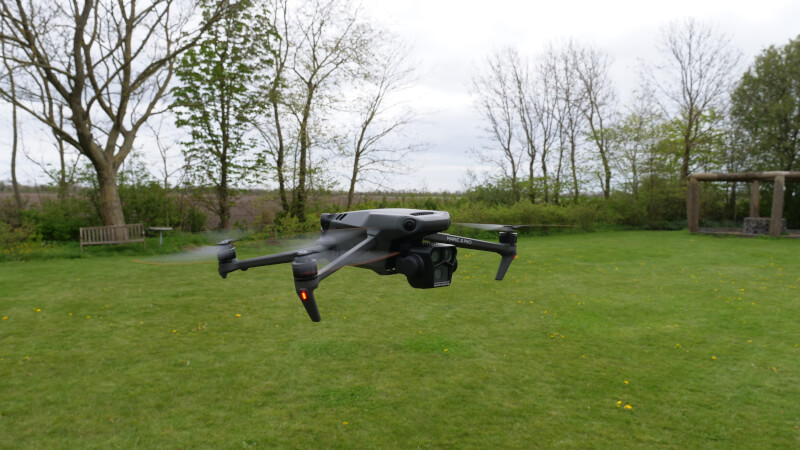
Specifications
- Takeoff Weight: 958 g
- Dimensions:
- Folded (without propellers): 231.1×98×95.4 mm (L×W×H)
- Unfolded (without propellers): 347.5×290.8×107.7 mm (L×W×H)
- Max Ascent Speed: 8 m/s
- Max Descent Speed: 6 m/s
- Max Horizontal Speed (at sea level, no wind): 21 m/s
- Max Takeoff Altitude: 6000 m
- Max Flight Time: 43 minutes
- Max Hovering Time: 37 minutes
- Max Flight Distance: 28 km
- Global Navigation Satellite System: GPS + Galileo + BeiDou
- Camera
- Image Sensor
- Hasselblad Camera: 4/3 CMOS, Effective Pixels: 20 MP
- Medium Tele Camera: 1/1.3″ CMOS, Effective Pixels: 48 MP
- Tele Camera: 1/2″ CMOS, Effective Pixels: 12 MP
- Lens
- Hasselblad Camera:
- FOV: 84°
- Format Equivalent: 24mm
- Aperture: f/2.8-f/11
- Focus: 1 m to ∞
- Medium Tele Camera:
- FOV: 35°
- Format Equivalent: 70mm
- Aperture: f/2.8
- Focus: 3 m to ∞
- Tele Camera:
- FOV: 15°
- Format Equivalent: 166mm
- Aperture: f/3.4
- Focus: 3 m to ∞
- Sensing System: Omnidirectional binocular vision system, supplemented with an infrared sensor at the bottom of the aircraft
I've trimmed a bit from the rather long complete list of specs above. Most central for many, and one of the big selling points of the DJI Mavic 3 Pro, is the camera setup it comes with, where we get three cameras. They allow for more flexible options without losing quality.
Here it is also worth noting that we got the DJI Mavic 3 Pro for testing in their Fly More Combo, which includes additional accessories, in the form of two extra batteries and a charging hub.
A walk around the DJI Mavic 3 Pro
If you have become familiar with the Mavic series from DJI before, you will quickly recognize the design. The colors are kept in the classic DJI dark gray and black combination.
Like all other current "ordinary" drones from DJI, this is of course also a foldable drone, which facilitates storage and transport. The four propeller arms can be folded around the body, so that the footprint of the drone becomes significantly smaller.
Included in the box is a small harness that can be fastened around the drone. It functions both as fastening of the propellers and protection for the gimbal and camera in the front.
You don't have to have the DJI Mavic 3 Pro in your hands for a long time before you discover how many sensors it is packed with.
The advanced Obstacle Sensing system means that there are sensors in all directions on the drone. A total of eight wide-angle sensor cameras ensure that the drone scans for and avoids objects and obstacles.
It is quite a bit more comprehensive than the otherwise very good solution that we saw on the DJI Mini Pro drone we saw last summer. I will look at the practical part of it in more detail in the test later.
One of the most central parts of a drone is of course the camera, or in this case the cameras, as there are three in total.
The camera unit is of course located in the front in a gimbal, which ensures stable images during flight.
Compared to the previous Mavic 3, it has now been upgraded from two to three cameras. The main camera is a 20MP 4/3” CMOS f/2.8-f/11 lens made in collaboration with Hasselblad. It is complemented by two telephoto lenses. A 48 MP, 1/1.3” CMOS, f/2.8 with 3x optical zoom and a 12 MP, ½” CMOS, f/3.4 with 7x optical zoom and 28x hybrid zoom.
DJI itself states that the setup is equivalent to having a drone equipped with 24 mm, 70 mm and a 166 mm lens, if it is to be transferred to a regular camera comparison.
The batteries for the DJI Mavic 3 Pro are a good deal larger than those I have seen in the DJI Drones I have tested so far. DJI lists the flight time at 43 minutes under optimal conditions.
Another nice, but invisible feature is that we now get 1 TB of internal storage in the drone, which means that you don't necessarily need to grab a MicroSD card. However, it is still a very good idea, which I will get into more later.
All the new sensors, large batteries and new camera setup mean that the drone lands with a total weight with battery of 958 grams. This means that it is quite a bit above the 250 gram limit that is set for the most lenient drone regulations.
If we look at the supplied DJI RC remote, it is a complete unit with screen. The front is of course characterized by the steering. You have the two joysticks at the top of each side and between them, there are a series of diodes that indicate the remaining battery in the device.
The two control sticks can be unscrewed and can be stored on the underside of the unit for easy transport.
There is also a power button along with a mode switch that can switch between Cine, Normal and Sport, which are the three modes your drone can be set in.
What takes up the most space on the device is the 5.5" Full HD touch display, which is used for the DJI Fly app that is integrated on the DJI RC device.
At the top of the device there are two buttons, the left one is used to stop or start video recording and the right one is used for still images.
Below the two buttons are two rotary knobs. The left one is used to control the tilt of the camera and the right one is used for zoom.
At the bottom we find a USB C port, which is used to connect the DJI RC device to your computer, or to charge the device. It is also here that, under a small silicone cover, you find space for a MicroSD card and another USB C port. The USB C port can be used to connect a DJI Cellular Dongle.
If we finish with the underside of the DJI RC unit, we can see the two places for joysticks during transport and then there are two buttons that can be programmed for special functions via the DJI Fly software.
The entire DJI RC unit feels nice and solid and, despite the many features, is ready with a weight of only 390 grams, so it is comfortable to carry.
DJI states the battery life of the DJI RC unit for around four hours of use. Built into the unit are of course also the solid transmitters that create the connection to your drone.
The DJI RC unit can be used for all drones that use O3+ transmission and DJI states that the maximum distance can reach up to 15 km. It is of course under super optimal conditions that this kind of thing can be achieved.
As part of the Fly More Combo option, two extra batteries are also included, along with a charging stand that can house all three batteries. To top it all off, there are also USB C cables and a charger with two USB C plugs so that it is possible to charge both the RC Remote unit and the three batteries at once.
The set also includes a set of ND filters for the cameras. There are a total of four filters consisting of ND8, ND16, ND32 and ND64 filters collected in a robust transport package.
Everything can be collected in a practical and robust transport bag which can contain all the parts together with the extra propellers that are also included.
Materials and build quality of both the DJI Mavic 3 Pro drone and the accessories feel solid and complete all around.
Software
The software on which a large part of the interaction with your DJI Mavic 3 Pro drone will take place is the DJI Fly app, which can be found on its smartphone, or as in our case on the DJI RC device.
It is from here that you can control a large part of the functions built into the DJI Mavic 3 Pro. The steering itself is of course done with the two joysticks. However, all adaptations of settings and setup of which parameters you want to fly take place through the DJI Fly software.
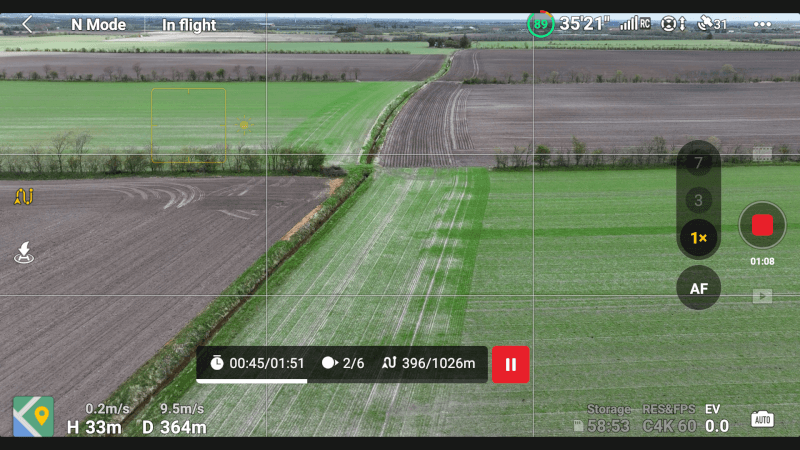
The drone has a range and options that go beyond the current legislation in Denmark and the EU. So it is up to you to check yourself that the settings for, for example, height, etc., are set so that they comply with the rules.
In the same way, you can specify how the drone should behave when it encounters obstacles in its path.
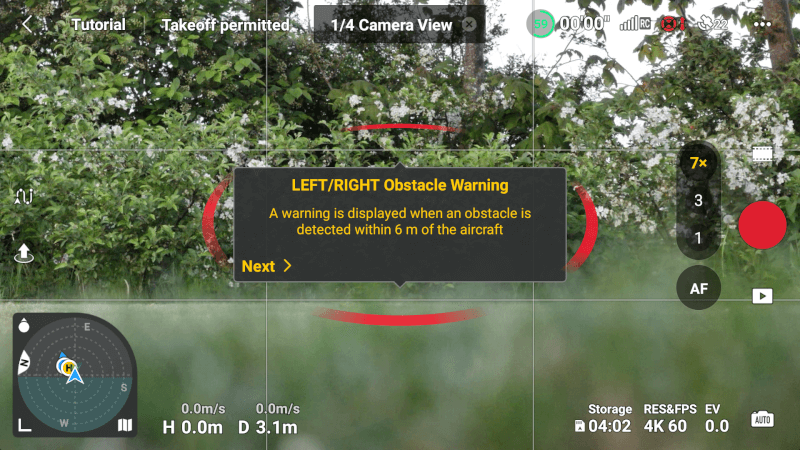
You can also set a ton of different things around the cameras and the gimbal that keeps it all stable.
During flight, there are a number of different status indicators that tell you things like how far the drone is from you and how much battery time is left.
In addition to the option to set the drone to avoid obstacles itself, there are also a number of other good automated functions. This includes automatic take off and landing.
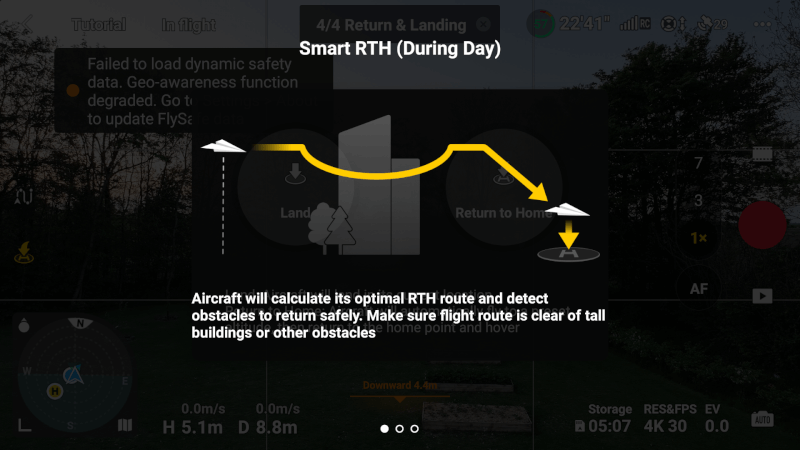
Every time the DJI Mavic 3 Pro takes off, it saves its GPS position. So if the drone loses connection to you and the controller, or is about to run out of battery, it will automatically return home and land. In the same way, you can at any time ask it to return home to the starting point.
The DJI Fly software seems super robust and with a lot of functions that can appeal to both the beginner and the more trained drone operator.
I experienced no problems with the software during my testing.
A little about Danish/EU legislation
I will not go into too much depth with the law here, but just take the time to mention it. There are a number of rules in the area and in the worst case you can be punished if you end up violating the rules for drone flying, whether it is consciously or unconsciously.
Since the DJI Mavic 3 Pro weighs over 250 grams, there are quite a few more restrictions on it compared to the drones we have previously reviewed.
In order to be allowed to fly with it, you must have passed the theoretical A1/A3 test and therefore have a drone certificate, which of course must also be brought with you when you fly the drone. However, it can all be done digitally and is overall not super difficult to get through.
Another important detail is that you must have liability insurance that covers flying with drones in this category. It is an insurance that must be able to cover sums insured up to DKK 7 million, which is not exactly small.
There are also quite a few more restrictions on where you can fly compared to the smaller drones under 250 grams.
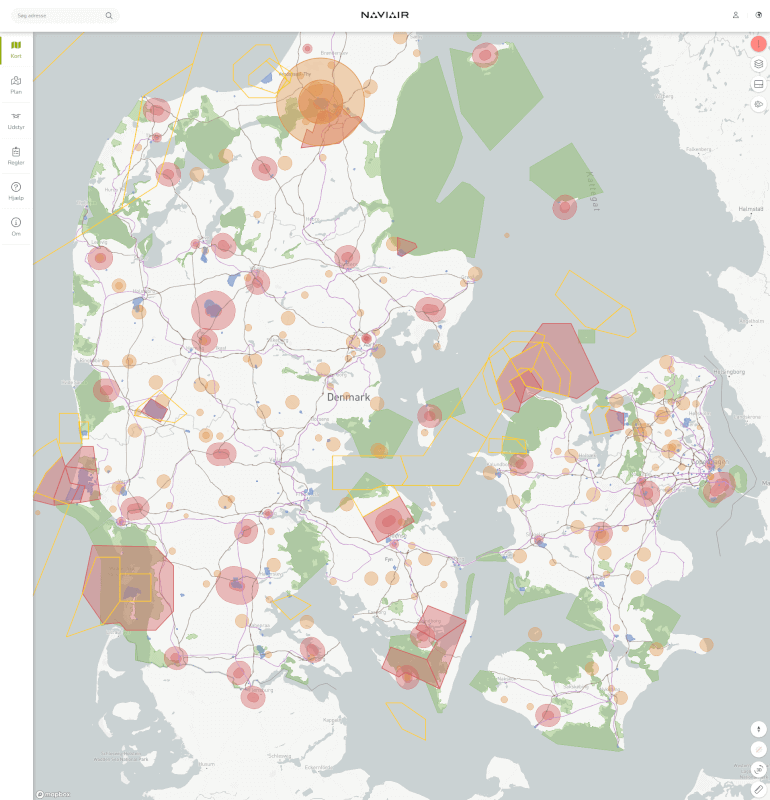
With the heavy drones in this class, you must keep a significantly greater safety distance and you must not fly in an area where there are unauthorized persons. This means that all flights in urban areas will in most cases be excluded or at least very limited without special permission.
You can get slightly less restrictions by taking the more extensive A2 Drone certificate. It does, however, require that you pass a theoretical test with an examiner approved by the Danish Transport Agency.
There is also practical self-learning, where you have to familiarize yourself with the drone you want to fly with, and a series of practical maneuvers you have to go through. Here there is no test you have to pass, but it is subject to control and the possibility of being selected for control, cf. below from the Danish Transport Agency:
"The practical self-training involves some specific maneuvers that must be completed before you can declare that you have completed the practical self-training. The self-training is subject to supervision, and you will be able to be selected for control if the Swedish Transport Agency deems it necessary. If we find it unlikely that you have carried out your practical self-training, we will deprive the remote pilot of his certificate of competence. "
These more extensive rules mean that there are very naturally quite a few more restrictions on how and not least where you can use a drone like the DJI Mavic 3 Pro. These are details that you have to take into consideration before you dive into purchasing and flying the drone.
In addition to the above rules, you must of course still be aware of the areas where there may be restrictions on flight, even if they immediately meet the other rules about distance etc. .
You can find much more about the rules and the different types of certificates on the Swedish Transport Agency's website www.droneregler.dk
It pays to spend some time familiarizing yourself with the rules for drone flying. It is not exactly an easy web of rules to sift through. Through other work, I am used to reading statutory texts and finding my way around public notices, and it took me a while to make sense of things. So if you want to be on the safe side, you should set aside some time for legal research.
The drone regulations are basically common European and apply throughout the EU. However, there may be additional rules in certain countries, so look out. Outside the EU, there may also be special rules that you must be aware of.
Testing
Given the somewhat more restrictive rules, my test flights with the DJI Mavic 3 Pro were a little more limited. I kept the flights limited to over my own house and the surrounding fields, by agreement with my neighbor who owns the fields.
Fortunately, I live in West Jutland with a good distance around me without the risk of unauthorized persons straying into the no-fly zone.
The actual experience of flying with the drone is wonderfully easy and straightforward and only easier if you have previously flown with a DJI drone.
The many automated functions and sensors on the Mavic 3 Pro mean that you almost have to make an effort to get off the ground.
It is of course possible to turn it all off if you want, as it gives a little more flexibility. Especially if you want to make recordings where you fly close to something, the sensors can be quite sensitive by default. This means that the drone stops or flies around in a different path than you might have intended.
There is of course a learning curve in relation to learning to fly a drone. However, it is not a particularly steep curve, and you get the hang of it fairly quickly. Especially if you have played a console with a controller, the feeling is in many ways the same here.
One of the most important aspects of a drone for many is of course the camera options and the photos and videos you can take with them.
It is even more pronounced with a drone like the Mavic 3 Pro, which has the photo and video part very much in focus in the marketing. The hardware part of the Mavic 3 Pro is impressive for a drone of this size, so on that front you have a good starting point.
As with much other photo and video equipment, good equipment does not automatically make you a good photographer. Of course, this also applies here, and it is a separate learning curve to control, frame and take good pictures or video while flying.
Once you have that learning in place, however, the Mavic 3 Pro can handle some absolutely fantastic images. As I touched on earlier, I was a bit limited in terms of grandiose possibilities, as the rules for flying a drone in this class are as restrictive as they are.
However, I think that my test flights and recordings in the area in the immediate vicinity of my home show the possibilities very well. See a clip of some of my test recordings right here below. Here, however, you should be aware that they suffer from YouTube's compression and therefore do not show the full quality of the recordings, which in their raw form are a notch sharper. At the same time, you can record in formats that don't quite fit into the YouTube sizes, so that's why there are some black bars around the recordings.
Especially the Zoom options impressed me. I live about 30 km south of Esbjerg, but with 18x zoom it still feels like you can get pretty close.
All the many sensors in the Mavic 3 Pro also mean that there are good options for tracking. It can be used to automatically make the drone follow people, vehicles or anything else. Again, I was a little limited in my testing options, but the bit I tried worked flawlessly.
At the same time, there is also the possibility of a number of automatic maneuvers and drone shots, which can provide some interesting shots in a quick and easy way.
Via the DJI Fly software, it is also possible to plan a flight route via GPS waypoints. In this way, you can send the drone off on a planned route, without having to control it yourself along the way.
It can also be used to fly through exactly the same route at different times if you want shots of the same locations in different settings.
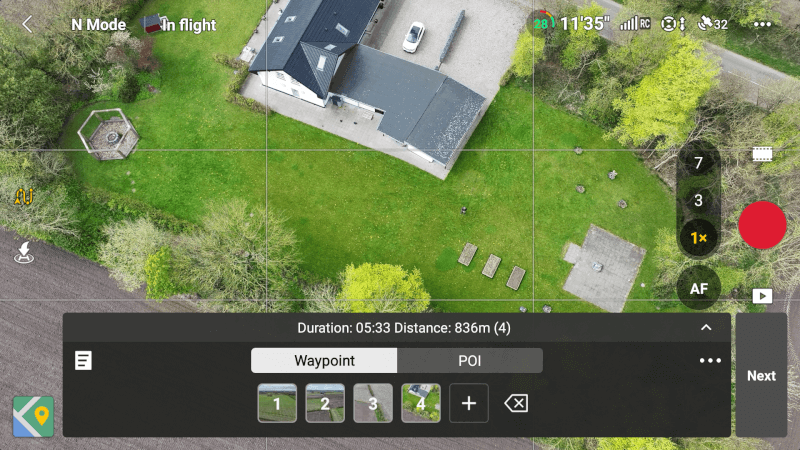
It is possible to record movies and photos in a multitude of different settings. On the main camera, there is the possibility of video up to 5.1K/50 fps or 4K/120fps. 4K/60 fps is possible on the Medium telephoto and telephoto lenses. This is where the SD card comes into play, despite the internal 1TB storage.
If you want to record in the highest quality, there is only room for about 5 minutes of video on the internal storage. So it's video formats that take up space.
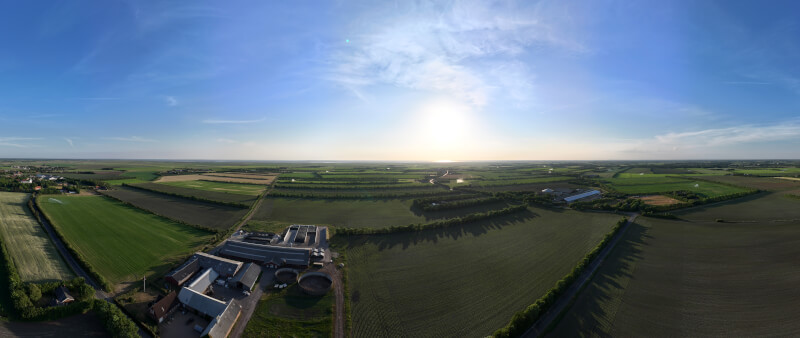
Overall, my time with the DJI Mavic 3 Pro has been a pleasure. The strict rules have been quite restrictive, but there is nothing to be done about that sort of thing. The experience of flying and recording with the drone has been easy and straightforward, and I wish I had had the opportunity to try out the many functions in more epic surroundings than the flat, drought-stricken West Jutland.
Price
I can currently find the DJI Mavic 3 Pro Fly More Combo with an online price of just under 3.500$. The regular version without extra accessories can be had for DKK 2.800$.
It is undoubtedly a high price and in fact more than twice as high as the DJI Mini 3 Pro which we have seen as the most expensive drone so far.
However, it must be said that you get a super advanced drone with a sea of advanced features.
Conclusion
There is no doubt that a drone like the DJI Mavic 3 Pro is not made for the average hobby drone fan. The price alone will undoubtedly deter many from jumping on it as an opportunity for a new hobby.
However, the challenge also stems from the rather restrictive rules for flying a drone in this class. The restrictions on where you can fly the drone will naturally make it impractical for most hobbyists who want to capture pictures and video of their vacation or similar.
There is no doubt that the DJI Mavic 3 Pro is technically a fantastic drone. It is, despite the very advanced options, easy to use and quick to learn.
The automatic functions such as tracking, flight path, takeoff/landing etc mean you can get some great photos and movies with a minimum of work
Overall, the DJI Mavic 3 Pro is technically a fantastic product, which takes some absolutely outstanding photos and is a pleasure to fly at the same time.
However, it is difficult to avoid the fact that the legal restrictions will mean that I will clearly prefer a less advanced variant, such as a Mini 3 Pro or similar.
It is of course a personal assessment of needs that must be decisive for what you choose. If you are aware of the limitations that come with a drone in this class, and despite that can find a use for it, and not least have a fairly large budget, then I would definitely recommend the DJI Mavic 3 Pro.
We end up with a final grade of 9 and an Enthusiast Only Award for a product that is simultaneously packed with advanced features and technology, but still easy to use.
Pros:
- Easy to use
- Packed with advanced features
- The automatic functions provide a sea of possibilities
Cons
- Legislation can greatly limit applicability
- The price is high


Latest gadgets
-
19 Sepgadgets
-
23 Maygadgets
LaserPecker LP5 Laser Engraver
-
01 Maygadgets
Swytch launches Swytch Max+ Kit
-
10 Margadgets
DJI AIR 3S
-
03 Margadgets
Razer Wolverine V3 Pro
-
21 Febgadgets
OBSBOT Tiny 2 SE
-
13 Febgadgets
Corsair launches Platform:4
-
17 Jangadgets
Nerdytek Cycon3
Most read gadgets
Latest gadgets
-
19 Sepgadgets
DJI launches Mini 5 Pro
-
23 Maygadgets
LaserPecker LP5 Laser Engraver
-
01 Maygadgets
Swytch launches Swytch Max+ Kit
-
10 Margadgets
DJI AIR 3S
-
03 Margadgets
Razer Wolverine V3 Pro
-
21 Febgadgets
OBSBOT Tiny 2 SE
-
13 Febgadgets
Corsair launches Platform:4
-
17 Jangadgets
Nerdytek Cycon3






